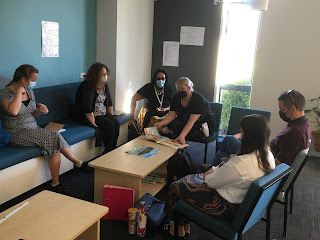In a previous life I had an interest in pictorial archives (well, I still do, but back then it was a professional interest, too). I was fascinated by the challenge of looking into photos of the past, trying to discern the layers of life that were often hidden under our very noses.
Last week I took this photo in our staffroom. It was one small part of a session in which our 'hurumanu' leaders were working with small groups of staff supporting their mahi with our learners. This is one such photo, and it has quite a number of layers of meaning and activity. As is so often the case when looking at photos, the layers are not obvious at first glance.
The Hurumanu leader (Sarah) is leading the team through the use of a picture book. The book ('The house that Jack built', by Gavin Bishop) told a traditional story, but with a Māori lens, with Māori characters. Sarah's professional lens was one of critical literacy, of digging down into the story: who was present in the story and who was not? Whose voices are we hearing, and whose were missing? What was the obvious message? What was the less obvious message?
The re-telling of the story with a Māori lens also captured the work that we have accessed with the support of Dr Aaron Wilson of the University of Auckland, that of the need for text to be both a window and a mirror for the reader. Windows allow readers to see into the lives of others. Mirrors allow the reader to see themselves in the story, something so important for learners from diverse ethnic backgrounds. Readers need to be able to 'see themselves' in the texts if the texts are to retain relevance, and to impact most powerfully on the learner.
Both of these issues are brought to the forefront for us because of our engagement with The Manaiakalani Programme. This mahi shares what our collective research and data has revealed as 'High Leverage Practices', things we can do in our kura that make the greatest difference. We most probably wouldn't have been doing these things had we not been part of this transformational mahi.
The photo captures what I have said for a long time. Often we don't need external people to tell us how to do things (sometimes we do, of course), we have the expertise within our kura, we know how to solve many of the challenges that exist within our education system. We just have to have a body politic that trusts us to do that, and school leadership that keeps its eye on the ball, focussing on those challenges and, more importantly, the solutions.
Two of the people in the picture are interns/trainees from the Graduate School of Education. It says everything about the quality of the interns, and the values that they gather from NZGSE, that they remain with us well after 3pm, engaging alongside us in our own learning journeys, adding our knowledge and expertise to their own kete. That is not often the case with teachers in training from elsewhere.
The text was chosen deliberately to offer something for everyone, from those with a reading age of seven, to Year 10 and 11 students looking for deeper meaning. The text is being used in our 'hurumanu', that's our compound word for our junior cross curriculum work, in this case English and social studies working together. And as if that weren't enough, it is a piece of work that sits inside the new New Zealand Histories curriculum. Tūmeke!!
So there are indeed many layers of content and meaning from this one photo. It is easy for staff, when they have their heads 'down below the parapet' (if you'll forgive the military metaphor) to lose sight of the skills that they have, and the amazing mahi that they are doing. We see this right across our Uru Mānuka kāhui ako, and across the Manaiakalani network of Aotearoa - amazing staff, always looking to increase their skill set, driven by their moral imperative to do the best by our learners.
Tino pai tō mahi, e hoa mā

Kia ora Robin. What's in a photo ... a lot!! This is collective teacher efficacy (CTE) in action, effect size 1.57, the number 1 influence related to student achievement. When teachers start to believe it is what they can do that makes the difference ... anything is possible! Tūmeke, thanks for sharing.
ReplyDeleteKia ora Gary
DeleteCTE indeed... and as with so many other tings I don't believe it just happens... when you fertilise and cultivate the soil, you enable great gardens to grow.
Nā
R
Tena koe Matua. This is an excellent reminder of the magic that collaboration and cross-pollination of curricula can produce.
ReplyDeleteKia ora Jo
DeleteYes, Yes, and Yes...we have been intentional and deliberate about tying to cultivate these very things. It doesn't just happen, eh!!
Nā
R